Related Research Articles

Year 1529 (MDXXIX) was a common year starting on Friday of the Julian calendar.

The Church of Sweden is an Evangelical Lutheran national church in Sweden. A former state church, headquartered in Uppsala, with around 5.4 million members at year end 2023, it is the largest Christian denomination in Sweden, the largest Lutheran denomination in Europe and the third-largest in the world, after the Ethiopian Evangelical Church Mekane Yesus and the Evangelical Lutheran Church in Tanzania.

The Evangelical Lutheran Church of Finland is a national church of Finland. It is part of the Lutheran branch of Christianity. The church has a legal position as a national church in the country, along with the Orthodox Church of Finland.

The early Vasa era is a period in Swedish history that lasted between 1523–1611. It began with the reconquest of Stockholm by Gustav Vasa and his men from the Danes in 1523, which was triggered by the event known as the Stockholm Bloodbath in 1520, and then was followed up by Sweden's secession from the Kalmar Union, and continued with the reign of Gustav's sons Eric XIV, John III, John's son Sigismund, and finally Gustav's youngest son Charles IX. The era was followed by a period commonly referred to as the Swedish Empire, or Stormaktstiden in Swedish, which means "Era Of Great Power".

Olof Persson, sometimes Petersson, better known under the Latin form of his name, Olaus Petri, was a clergyman, writer, judge, and major contributor to the Protestant Reformation in Sweden. His brother, Laurentius Petri, became the first Evangelical Lutheran Archbishop of Sweden.

The Catholic Church in Sweden is part of the worldwide Catholic Church in communion with the Pope in Rome. It was established by Archbishop Ansgar in Birka in 829, and further developed by the Christianization of Sweden in the 9th century. King Olof Skötkonung is considered the first Christian king of Sweden.
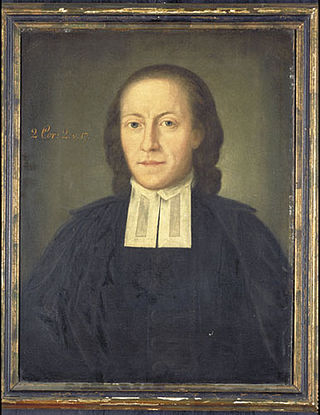
Henric Schartau was a Swedish Lutheran pietistic priest. His theology, including his characteristic teachings on the "order of grace", influenced a revivalist movement known as Schartauanism.
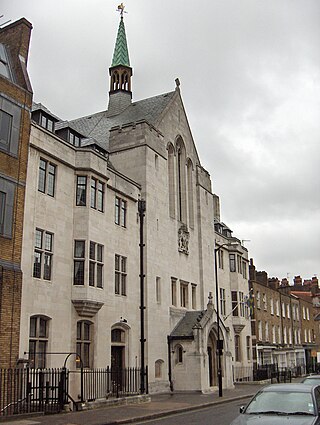
The Church of Sweden Abroad is an institution of the Evangelical Lutheran Church of Sweden. The Church of Sweden Abroad has more than 40 parishes throughout the world, concentrated in Western Europe. Another 80 cities are served by visiting clergy.
Theodore Hamberg was a Swedish missionary and author active in China. He is known for his role in having authored an important account on the early Taiping rebellion and for his role in establishing Christian missions in Guangdong province. He also laid the foundations for the study of the Hakka dialect in the West.
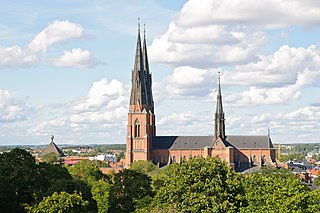
Religion in Sweden has, over the years, become increasingly diverse. Christianity was the religion of virtually all of the Swedish population from the 12th to the early 20th century, but it has rapidly declined throughout the late 20th and early 21st century.
The Swedish Church Ordinance of 1571 was the first complete Swedish church order following the Swedish Reformation in the 1520s.

The Reformation in Sweden is generally regarded as having begun in 1527 during the reign of King Gustav I of Sweden, but the process was slow and was not definitively decided until the Uppsala Synod of 1593, in the wake of an attempted counter-reformation during the reign of John III (1568–1592).
Widow conservation was a practice in Protestant Europe in the early modern age, when the widow of a parish vicar would marry her husband's successor to the vicarage to ensure her economic support. The practice was common in Scandinavia (Änkekonservering/Enkekonservering) and Protestant parts of Germany. It is related to other forms of widow inheritance, including the levirate marriage known in the Old Testament as yibbum.

Olof Sundby was a Swedish bishop within the Church of Sweden. He was the archbishop of Uppsala in the period 1972–1983.

Sko Abbey, was a Cistercian nunnery in Sweden, in operation from 1230 until at least 1588. It was located in the Skokloster parish in Uppland. It was the predecessor of the baroque Skokloster Castle.
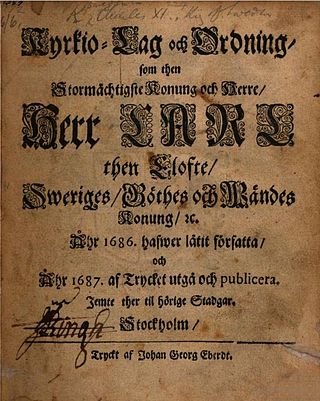
The Swedish Church Law 1686 was a Swedish law which regulated the relationship between the state and the church in Sweden from 1686 until the Swedish Church Law 1992, as well as in Finland until 1870. It replaced the previous Swedish Church Ordinance 1571.
The Reduction of Gustav I of Sweden, was an important reform during the Protestant Swedish Reformation, in which king Gustav I of Sweden ordered a reduction in church property and the return of land to the crown, making the national church dependent upon the monarch and effectively ending Swedish monastic life. This organised confiscation and transfer of the property of the Swedish Catholic church to the Crown – initiated at the Västerås riksdag of 1527 and finalised in the 1540s – was the economic phase of the Swedish Reformation and was followed by the Örebro Synod, which dealt with theological matters.

Läsare or the Reader movement was a Swedish Pietistic Christian revival movement of people who stressed the importance of reading, that is, reading the Bible and other Christian literature. It was influenced by both the Herrnhuters and the Methodists and has been described by scholar George M. Stephenson as a "second religious reformation in Sweden".
The Swedish Mission Society, was a Swedish Christian organization to promote mission work among the Sámi in Sweden.
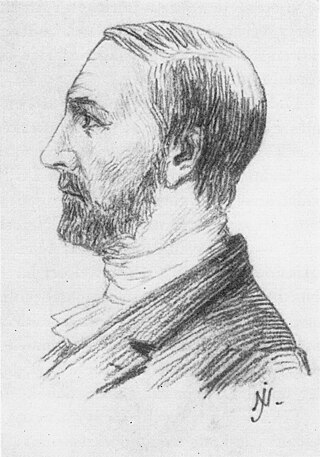
Per August Ahlberg was a Swedish revivalist pastor and missionary who made a large impact on the spiritual environment of Småland, Sweden, founding a number of mission schools for colporteurs.
References
- ↑ Holweck, Frederick (1908). "Candlemas". The Catholic Encyclopedia. Vol. 3. New York: Robert Appleton Company.
- ↑ Carl Alfred Cornelius: Svenska kyrkans historia efter reformationen, förra delen (1520-1693), 1886-87
- Carl Alfred Cornelius: Svenska kyrkans historia efter reformationen, förra delen (1520-1693), 1886–87
You can help expand this article with text translated from the corresponding article in Swedish. (December 2017)Click [show] for important translation instructions.
|
